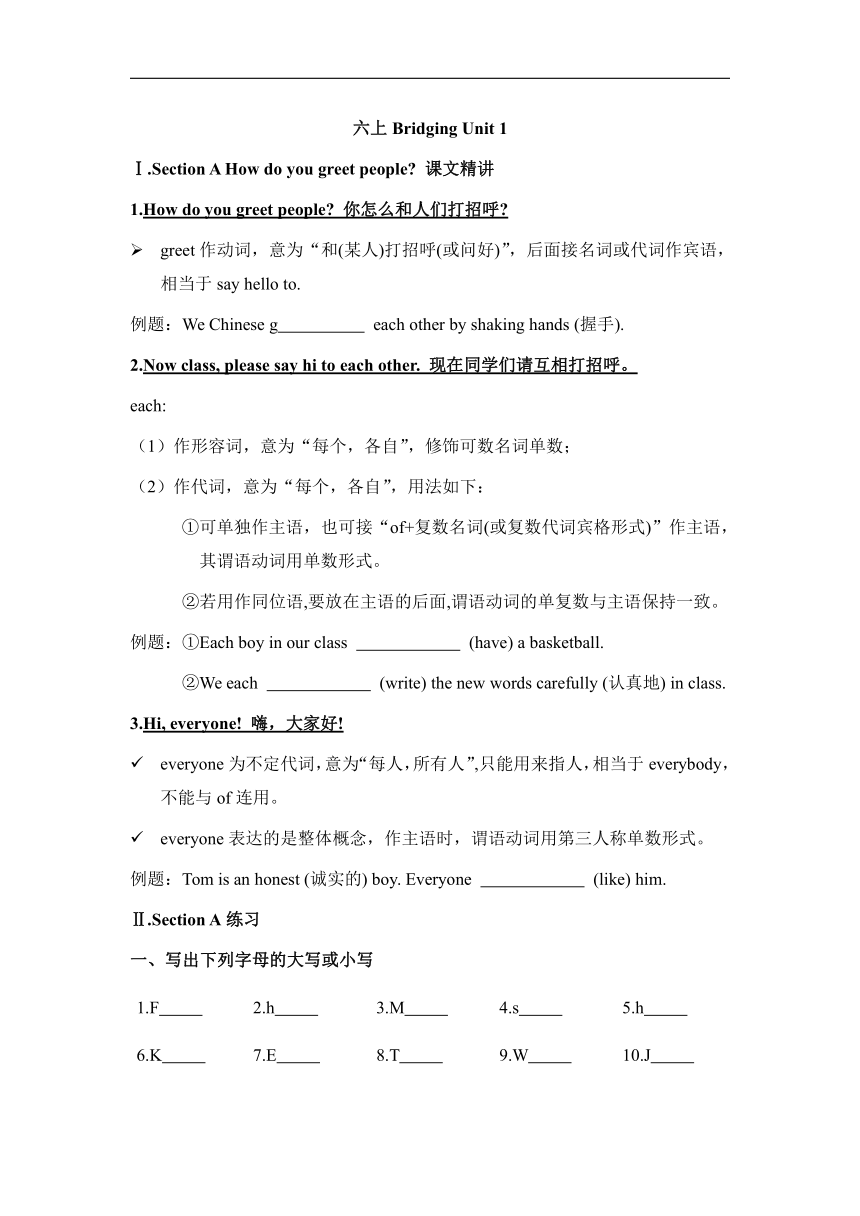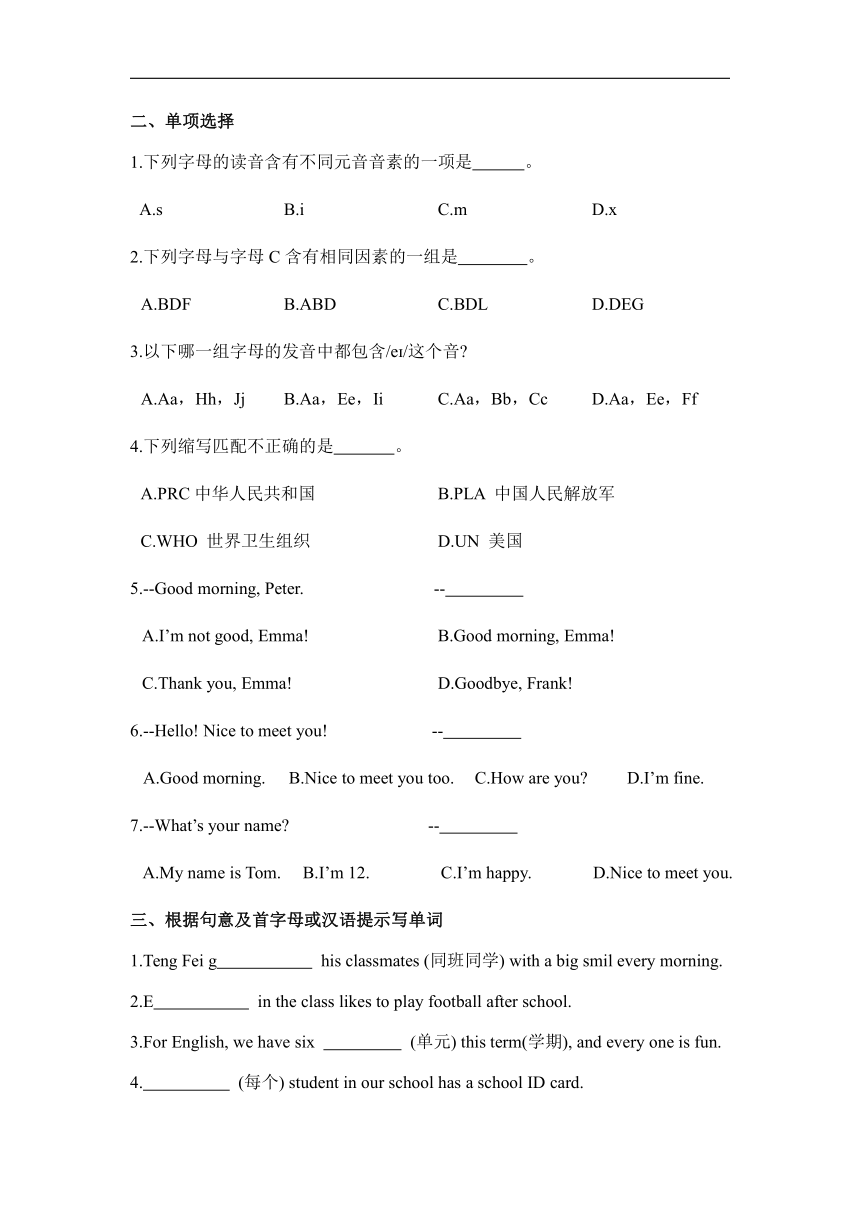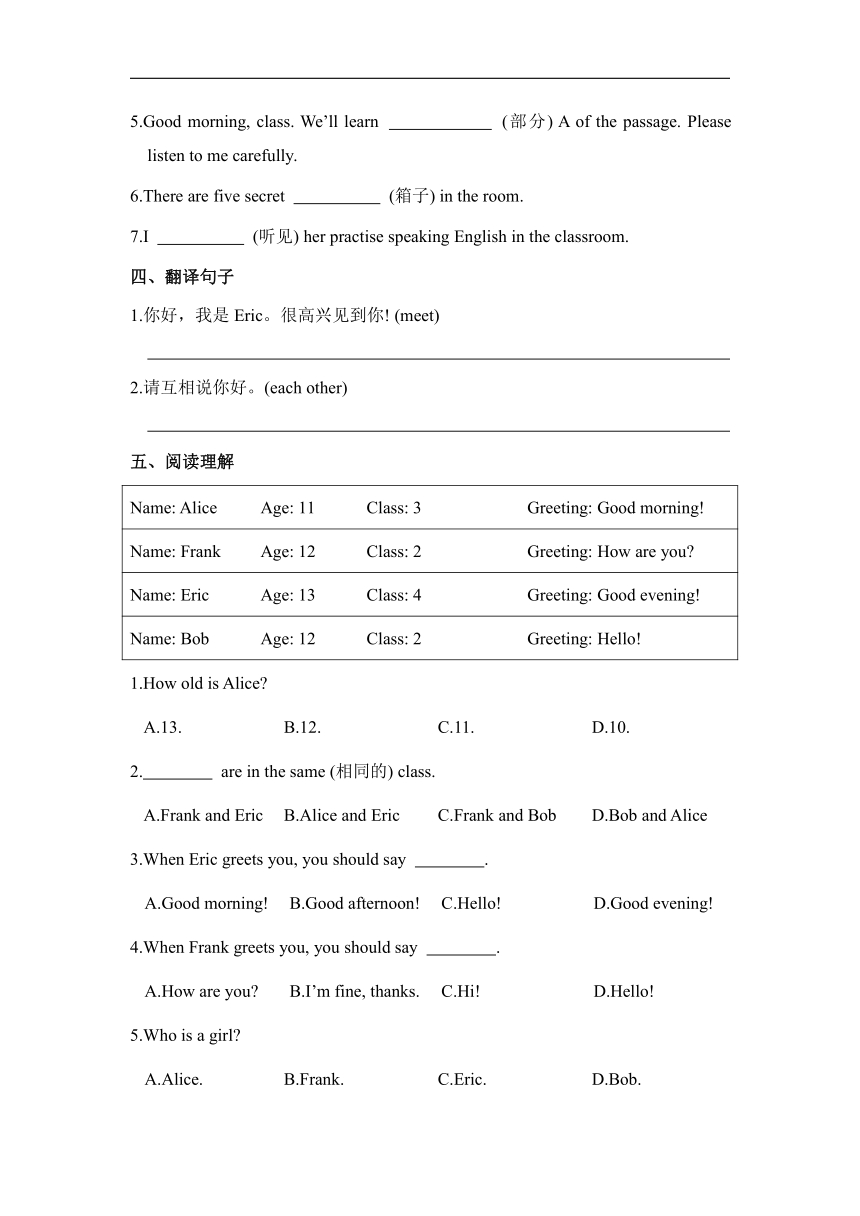Bridging Unit1 Hello基础知识及练习(无答案)鲁教版(五四学制)(2024)六年级英语上册
文档属性
| 名称 | Bridging Unit1 Hello基础知识及练习(无答案)鲁教版(五四学制)(2024)六年级英语上册 |  | |
| 格式 | docx | ||
| 文件大小 | 33.4KB | ||
| 资源类型 | 教案 | ||
| 版本资源 | 鲁教版 | ||
| 科目 | 英语 | ||
| 更新时间 | 2025-07-02 17:36:52 | ||
图片预览



文档简介
六上Bridging Unit 1
Ⅰ.Section A How do you greet people 课文精讲
1.How do you greet people 你怎么和人们打招呼
greet作动词,意为“和(某人)打招呼(或问好)”,后面接名词或代词作宾语,相当于say hello to.
例题:We Chinese g each other by shaking hands (握手).
2.Now class, please say hi to each other. 现在同学们请互相打招呼。
each:
(1)作形容词,意为“每个,各自”,修饰可数名词单数;
(2)作代词,意为“每个,各自”,用法如下:
①可单独作主语,也可接“of+复数名词(或复数代词宾格形式)”作主语,其谓语动词用单数形式。
②若用作同位语,要放在主语的后面,谓语动词的单复数与主语保持一致。
例题:①Each boy in our class (have) a basketball.
②We each (write) the new words carefully (认真地) in class.
3.Hi, everyone! 嗨,大家好!
everyone为不定代词,意为“每人,所有人”,只能用来指人,相当于everybody,不能与of连用。
everyone表达的是整体概念,作主语时,谓语动词用第三人称单数形式。
例题:Tom is an honest (诚实的) boy. Everyone (like) him.
Ⅱ.Section A练习
一、写出下列字母的大写或小写
1.F 2.h 3.M 4.s 5.h
6.K 7.E 8.T 9.W 10.J
二、单项选择
1.下列字母的读音含有不同元音音素的一项是 。
A.s B.i C.m D.x
2.下列字母与字母C含有相同因素的一组是 。
A.BDF B.ABD C.BDL D.DEG
3.以下哪一组字母的发音中都包含/e /这个音
A.Aa,Hh,Jj B.Aa,Ee,Ii C.Aa,Bb,Cc D.Aa,Ee,Ff
4.下列缩写匹配不正确的是 。
A.PRC中华人民共和国 B.PLA 中国人民解放军
C.WHO 世界卫生组织 D.UN 美国
5.--Good morning, Peter. --
A.I’m not good, Emma! B.Good morning, Emma!
C.Thank you, Emma! D.Goodbye, Frank!
6.--Hello! Nice to meet you! --
A.Good morning. B.Nice to meet you too. C.How are you D.I’m fine.
7.--What’s your name --
A.My name is Tom. B.I’m 12. C.I’m happy. D.Nice to meet you.
三、根据句意及首字母或汉语提示写单词
1.Teng Fei g his classmates (同班同学) with a big smil every morning.
2.E in the class likes to play football after school.
3.For English, we have six (单元) this term(学期), and every one is fun.
4. (每个) student in our school has a school ID card.
5.Good morning, class. We’ll learn (部分) A of the passage. Please listen to me carefully.
6.There are five secret (箱子) in the room.
7.I (听见) her practise speaking English in the classroom.
四、翻译句子
1.你好,我是Eric。很高兴见到你! (meet)
2.请互相说你好。(each other)
五、阅读理解
Name: Alice Age: 11 Class: 3 Greeting: Good morning!
Name: Frank Age: 12 Class: 2 Greeting: How are you
Name: Eric Age: 13 Class: 4 Greeting: Good evening!
Name: Bob Age: 12 Class: 2 Greeting: Hello!
1.How old is Alice
A.13. B.12. C.11. D.10.
2. are in the same (相同的) class.
A.Frank and Eric B.Alice and Eric C.Frank and Bob D.Bob and Alice
3.When Eric greets you, you should say .
A.Good morning! B.Good afternoon! C.Hello! D.Good evening!
4.When Frank greets you, you should say .
A.How are you B.I’m fine, thanks. C.Hi! D.Hello!
5.Who is a girl
A.Alice. B.Frank. C.Eric. D.Bob.
Ⅲ.Section B How do you start a conversation 课文精讲
1.How do you start a conversation 你如何开始一段对话
start:
作动词,后接名词、不定式或动词-ing形式,其同义词为begin;
常用短语:start with...,意为“从......开始”;
作名词,其同义词为beginning;
常用短语:at the start of... = at the beginning of...,意为“在......的开始”。
例题:My brother started (play) football when he was 7 years old.
2.How do you start a conversation 你如何开始一段对话
conversation常指非正式场合下的谈话;
用作可数名词时,指某次具体的谈话;
用作不可数名词时,泛指谈话,不指某次具体的谈话。
常用短语:
①have/hold a conversation with...,意为“与......交谈”,
相当于have a talk with sb.或talk with sb.;
②be in conversation with...,意为“在与......交谈”。
例题:We can start a c by talking about the weather.
Ⅳ.Section B练习
一、单项选择
1.以下哪一组单词是按照它们在词典中出现的顺序排列的
A.carrot,dog,band,fish B.across,hat,sit,page
C.husband,in,jump,key D.flag,cow,horse,ant
2.--Can you “see”
A.find B.need C.greet D.spell
二、根据句意及首字母或汉语提示写单词
1.I love poems (诗). I s to write poems this year.
2.How do you (拼写) this word
3.It is very good for me to have (对话) with friends in English every day.
4.The (铃) rings at 6:00 a. m. Then I get up.
三、用括号内所给词的适当形式填空
1.--How your grandma --She fine, thank you. (be)
2.Nice (meet) you, Ms Gao.
3.Here comes our English teacher. Let’s (greet) her.
四、翻译句子
1.--你好吗 --我很好,谢谢。 (fine)
--
--
2.--我可以知道你的名字吗 --John。 (may)
--
--
3.请问你如何拼写你的名字 (spell)
4.到上课时间了。 (time for)
五、完形填空
Good morning, everyone! I am 1. English teacher. Let’s get to know each other. My name 2. Tom Keen. Tom is my first name and Keen is my last name. Can you 3. it T-O-M, Tom. K-E-E-N, Keen. You can 4.
me Mr Keen or Tom. Nice to 5. all of you. I’m glad to be your 6.
Hey, boy. 7. I have your name Your name is Tom! Oh, 8. both (两) have the same name. That’s the 9. . It’s time 10. lunch.
1.A.my B.his C.her D.your
2.A.be B.is C.am D.are
3.A.know B.tell C.spell D.say
4.A.call B.see C.speak D.listen
5.A.greet B.start C.meet D.go
6.A.friend B.father C.cousin D.grandpa
7.A.May B.Do C.How D.What
8.A.they B.we C.she D.he
9.A.class B.bell C.book D.name
10.A.in B.of C.for D.to
六、阅读表达
Using a dictionary
cage noun 笼子 A cage is a box or room with bars. Pets like mice and gerbils (沙鼠) live in cages.
(4)① noun 蛋糕,糕点 A cake is food made with flour, butter, eggs and sugar. You bake a cake in the oven,
calculator noun 计算器 A calculator is a machine that you use to solve maths problems.
calendar noun 日历 A calendar is a list showing all the days, weeks and months in a year.
(4)② verb 呼唤;称呼,把......叫作 If you call someone, you speak loudly so that they will come to you. If a person or thing is called something, that is their name.
smell verb 闻,嗅 When you smell something, you use your nose to find out about it.
snail noun 蜗牛 A snail is a small, soft creature that lives inside a shell. Snails move very slowly.
(4)③ verb 打喷嚏 If you sneeze, air suddenly comes from your nose, making a noise.
snow noun 雪 Snow is small white pieces of frozen water. It falls from the sky in cold weather.
snowman noun 雪人 A snowman is a shape of a person made out of snow.
根据词典中的信息片段,完成下列任务。
1.There is a bird in the cage. (英译汉) 在 里有一只鸟。
2.Do you have next year’s calendar (英译汉)
你有明年的 吗
3.让我们出去堆一个雪人吧。 (汉译英)
Let’s go out to make a .
4.Please match the three words with ①②③ in the dictionary. (信息匹配)
a.call b.sneeze c.cake
① ② ③
5.We can see “smell” on page 146. On which page can we find “small”, page 145 or page 147 (No more than 3 words)
Ⅰ.Section A How do you greet people 课文精讲
1.How do you greet people 你怎么和人们打招呼
greet作动词,意为“和(某人)打招呼(或问好)”,后面接名词或代词作宾语,相当于say hello to.
例题:We Chinese g each other by shaking hands (握手).
2.Now class, please say hi to each other. 现在同学们请互相打招呼。
each:
(1)作形容词,意为“每个,各自”,修饰可数名词单数;
(2)作代词,意为“每个,各自”,用法如下:
①可单独作主语,也可接“of+复数名词(或复数代词宾格形式)”作主语,其谓语动词用单数形式。
②若用作同位语,要放在主语的后面,谓语动词的单复数与主语保持一致。
例题:①Each boy in our class (have) a basketball.
②We each (write) the new words carefully (认真地) in class.
3.Hi, everyone! 嗨,大家好!
everyone为不定代词,意为“每人,所有人”,只能用来指人,相当于everybody,不能与of连用。
everyone表达的是整体概念,作主语时,谓语动词用第三人称单数形式。
例题:Tom is an honest (诚实的) boy. Everyone (like) him.
Ⅱ.Section A练习
一、写出下列字母的大写或小写
1.F 2.h 3.M 4.s 5.h
6.K 7.E 8.T 9.W 10.J
二、单项选择
1.下列字母的读音含有不同元音音素的一项是 。
A.s B.i C.m D.x
2.下列字母与字母C含有相同因素的一组是 。
A.BDF B.ABD C.BDL D.DEG
3.以下哪一组字母的发音中都包含/e /这个音
A.Aa,Hh,Jj B.Aa,Ee,Ii C.Aa,Bb,Cc D.Aa,Ee,Ff
4.下列缩写匹配不正确的是 。
A.PRC中华人民共和国 B.PLA 中国人民解放军
C.WHO 世界卫生组织 D.UN 美国
5.--Good morning, Peter. --
A.I’m not good, Emma! B.Good morning, Emma!
C.Thank you, Emma! D.Goodbye, Frank!
6.--Hello! Nice to meet you! --
A.Good morning. B.Nice to meet you too. C.How are you D.I’m fine.
7.--What’s your name --
A.My name is Tom. B.I’m 12. C.I’m happy. D.Nice to meet you.
三、根据句意及首字母或汉语提示写单词
1.Teng Fei g his classmates (同班同学) with a big smil every morning.
2.E in the class likes to play football after school.
3.For English, we have six (单元) this term(学期), and every one is fun.
4. (每个) student in our school has a school ID card.
5.Good morning, class. We’ll learn (部分) A of the passage. Please listen to me carefully.
6.There are five secret (箱子) in the room.
7.I (听见) her practise speaking English in the classroom.
四、翻译句子
1.你好,我是Eric。很高兴见到你! (meet)
2.请互相说你好。(each other)
五、阅读理解
Name: Alice Age: 11 Class: 3 Greeting: Good morning!
Name: Frank Age: 12 Class: 2 Greeting: How are you
Name: Eric Age: 13 Class: 4 Greeting: Good evening!
Name: Bob Age: 12 Class: 2 Greeting: Hello!
1.How old is Alice
A.13. B.12. C.11. D.10.
2. are in the same (相同的) class.
A.Frank and Eric B.Alice and Eric C.Frank and Bob D.Bob and Alice
3.When Eric greets you, you should say .
A.Good morning! B.Good afternoon! C.Hello! D.Good evening!
4.When Frank greets you, you should say .
A.How are you B.I’m fine, thanks. C.Hi! D.Hello!
5.Who is a girl
A.Alice. B.Frank. C.Eric. D.Bob.
Ⅲ.Section B How do you start a conversation 课文精讲
1.How do you start a conversation 你如何开始一段对话
start:
作动词,后接名词、不定式或动词-ing形式,其同义词为begin;
常用短语:start with...,意为“从......开始”;
作名词,其同义词为beginning;
常用短语:at the start of... = at the beginning of...,意为“在......的开始”。
例题:My brother started (play) football when he was 7 years old.
2.How do you start a conversation 你如何开始一段对话
conversation常指非正式场合下的谈话;
用作可数名词时,指某次具体的谈话;
用作不可数名词时,泛指谈话,不指某次具体的谈话。
常用短语:
①have/hold a conversation with...,意为“与......交谈”,
相当于have a talk with sb.或talk with sb.;
②be in conversation with...,意为“在与......交谈”。
例题:We can start a c by talking about the weather.
Ⅳ.Section B练习
一、单项选择
1.以下哪一组单词是按照它们在词典中出现的顺序排列的
A.carrot,dog,band,fish B.across,hat,sit,page
C.husband,in,jump,key D.flag,cow,horse,ant
2.--Can you “see”
A.find B.need C.greet D.spell
二、根据句意及首字母或汉语提示写单词
1.I love poems (诗). I s to write poems this year.
2.How do you (拼写) this word
3.It is very good for me to have (对话) with friends in English every day.
4.The (铃) rings at 6:00 a. m. Then I get up.
三、用括号内所给词的适当形式填空
1.--How your grandma --She fine, thank you. (be)
2.Nice (meet) you, Ms Gao.
3.Here comes our English teacher. Let’s (greet) her.
四、翻译句子
1.--你好吗 --我很好,谢谢。 (fine)
--
--
2.--我可以知道你的名字吗 --John。 (may)
--
--
3.请问你如何拼写你的名字 (spell)
4.到上课时间了。 (time for)
五、完形填空
Good morning, everyone! I am 1. English teacher. Let’s get to know each other. My name 2. Tom Keen. Tom is my first name and Keen is my last name. Can you 3. it T-O-M, Tom. K-E-E-N, Keen. You can 4.
me Mr Keen or Tom. Nice to 5. all of you. I’m glad to be your 6.
Hey, boy. 7. I have your name Your name is Tom! Oh, 8. both (两) have the same name. That’s the 9. . It’s time 10. lunch.
1.A.my B.his C.her D.your
2.A.be B.is C.am D.are
3.A.know B.tell C.spell D.say
4.A.call B.see C.speak D.listen
5.A.greet B.start C.meet D.go
6.A.friend B.father C.cousin D.grandpa
7.A.May B.Do C.How D.What
8.A.they B.we C.she D.he
9.A.class B.bell C.book D.name
10.A.in B.of C.for D.to
六、阅读表达
Using a dictionary
cage noun 笼子 A cage is a box or room with bars. Pets like mice and gerbils (沙鼠) live in cages.
(4)① noun 蛋糕,糕点 A cake is food made with flour, butter, eggs and sugar. You bake a cake in the oven,
calculator noun 计算器 A calculator is a machine that you use to solve maths problems.
calendar noun 日历 A calendar is a list showing all the days, weeks and months in a year.
(4)② verb 呼唤;称呼,把......叫作 If you call someone, you speak loudly so that they will come to you. If a person or thing is called something, that is their name.
smell verb 闻,嗅 When you smell something, you use your nose to find out about it.
snail noun 蜗牛 A snail is a small, soft creature that lives inside a shell. Snails move very slowly.
(4)③ verb 打喷嚏 If you sneeze, air suddenly comes from your nose, making a noise.
snow noun 雪 Snow is small white pieces of frozen water. It falls from the sky in cold weather.
snowman noun 雪人 A snowman is a shape of a person made out of snow.
根据词典中的信息片段,完成下列任务。
1.There is a bird in the cage. (英译汉) 在 里有一只鸟。
2.Do you have next year’s calendar (英译汉)
你有明年的 吗
3.让我们出去堆一个雪人吧。 (汉译英)
Let’s go out to make a .
4.Please match the three words with ①②③ in the dictionary. (信息匹配)
a.call b.sneeze c.cake
① ② ③
5.We can see “smell” on page 146. On which page can we find “small”, page 145 or page 147 (No more than 3 words)
同课章节目录
